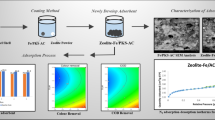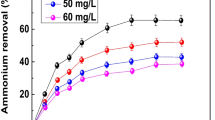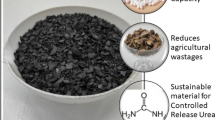Abstract
This study presents the use of chicken eggshells waste utilizing palm kernel shell based activated carbon (PKSAC) through the modification of their surface to enhance the adsorption capacity of H2S. Response surface methodology technique was used to optimize the process conditions and they were found to be: 500 mg/L for H2S initial concentration, 540 min for contact time and 1 g for adsorbent mass. The impacts of three arrangement factors (calcination temperature of impregnated activated carbon (IAC), the calcium solution concentration and contact time of calcination) on the H2S removal efficiency and impregnated AC yield were investigated. Both responses IAC yield (IACY, %) and removal efficiency (RE, %) were maximized to optimize the IAC preparation conditions. The optimum preparation conditions for IACY and RE were found as follows: calcination temperature of IAC of 880 °C, calcium solution concentration of 49.3% and calcination contact time of 57.6 min, which resulted in 35.8% of IACY and 98.2% RE. In addition, the equilibrium and kinetics of the process were investigated. The adsorbent was characterized using TGA, XRD, FTIR, SEM/EDX, and BET. The maximum monolayer adsorption capacity was found to be 543.47 mg/g. The results recommended that the composite of PKSAC and CaO could be a useful material for H2S containing wastewater treatment.
Similar content being viewed by others
References
Crini G. Non-Conventional Low-Cost Adsorbents for Dye Removal: A Review[J]. Bioresource Technology, 2006, 97: 1061–1085
Ma S, Noble A, Butcher D, et al. Removal of H2S Via an Iron Catalytic Cycle and Iron Sulfide Precipitation in the Water Column of Dead End Tributaries[J]. Estuarine, Coastal and Shelf Science, 2006, 70: 461–472
Montes RHO, Richter EM, Munoz RAA. Low-Potential Reduction of Sulfite at a Ruthenium-Oxide Hexacyanoferrate Modified Electrode[J]. Electrochemistry Communications, 2012, 21: 26–29
Diez N, Alvarez P, Granda M, et al. Tailoring Micro-Mesoporosity in Activated Carbon Fibers to Enhance SO2 Catalytic Oxidation[J]. Journal of Colloid and Interface Science, 2014, 428: 36–40
Chen Q, Wang J, Liu X, et al. Structure-Dependent Catalytic Oxidation of H2s over Na2CO3 Impregnated Carbon Aerogels[J]. Microporous and Mesoporous Materials, 2011, 142: 641–648
Cheng WP, Zhao JZ, Yang JG. Mgalfecu Mixed Oxides for SO2 Removal Capacity: Influence of the Copper and Aluminum Incorporation Method[J]. Catalysis Communications, 2012, 23: 1–4
Zhao L, Li X, Qu Z, et al. The Nial Mixed Oxides: The Relation between Basicity and SO2 Removal Capacity[J]. Separation and Purification Technology, 2011, 80: 345–350
Lemos BRS, Teixeira IF, de Mesquita JP, et al. Use of Modified Activated Carbon for the Oxidation of Aqueous Sulfide[J]. Carbon, 2012, 50: 1386–1393
El-Sharkawy EA, Soliman AY, Al-Amer KM. Comparative Study for the Removal of Methylene Blue Via Adsorption and Photocatalytic Degradation[J]. Journal of Colloid and Interface Science, 2007, 310: 498–508
Goyal M, Dhawan R, Bhagat M. Adsorption of Dimethyl Sulfide Vapors by Activated Carbons[J]. Colloids and Surfaces A: Physicochemical and Engineering Aspects, 2008, 322: 164–169
Bagreev A, Bandosz TJ. Study of Hydrogen Sulfide Adsorption on Activated Carbons Using Inverse Gas Chromatography at Infinite Dilution[J]. Journal of Physical Chemistry B, 2000, 104: 8841–8847
Seredych M, Hulicova-Jurcakova D, Lu GQ, et al. Surface Functional Groups of Carbons and the Effects of Their Chemical Character, Density and Accessibility to Ions on Electrochemical Performance[J]. Carbon, 2008, 46: 1475–1488
Castro JB, Bonelli PR, Cerrella EG, et al. Phosphoric Acid Activation of Agricultural Residues and Bagasse from Sugar Cane: Influence of the Experimental Conditions on Adsorption Characteristics of Activated Carbons[J]. Industrial and Engineering Chemistry Research, 2000, 39: 4166–4172
Rufford TE, Hulicova-Jurcakova D, Khosla K, et al. Microstructure and Electrochemical Double-Layer Capacitance of Carbon Electrodes Prepared by Zinc Chloride Activation of Sugar Cane Bagasse[J]. Journal of Power Sources, 2010, 195: 912–918
Marcilla A, Garcia-Garcia S, Asensio M, et al. Influence of Thermal Treatment Regime on the Density and Reactivity of Activated Carbons from Almond Shells[J]. Carobn, 2000, 38: 429–440
Martínez ML, Torres MM, Guzmán CA, et al. Preparation and Characteristics of Activated Carbon from Olive Stones and Walnut Shells[J]. Industrial Crops and Products, 2006, 23: 23–28
Lussier MG, Shull JC, Miller DJ. Activated Carbon from Cherry Stones[J]. Carbon, 1994, 32: 1493–1498
Kazemipour M, Ansari M, Tajrobehkar S, et al. Removal of Lead, Cadmium, Zinc, and Copper from Industrial Wastewater by Carbon Developed from Walnut, Hazelnut, Almond, Pistachio Shell, and Apricot Stone[J]. Journal of Hazardous Materials, 2008, 150: 322–327
Yang K, Peng J, Srinivasakannan C, et al. Preparation of High Surface Area Activated Carbon from Coconut Shells Using Microwave Heating[J]. Bioresource Technology, 2010, 101: 6163–6169
Habeeb OA, Ramesh K, Ali GAM, et al. Modeling and Optimization for H2S Adsorption from Wastewater Using Coconut Shell Based Activated Carbon[J]. Australian Journal of Basic and Applied Sciences, 2016, 10: 136–147
Martins AC, Pezoti O, Cazetta AL, et al. Removal of Tetracycline by Naoh-Activated Carbon Produced from Macadamia Nut Shells: Kinetic and Equilibrium Studies[J]. Chemical Engineering Journal, 2015, 260: 291–299
Farma R, Deraman M, Awitdrus A, et al. Preparation of Highly Porous Binderless Activated Carbon Electrodes from Fibres of Oil Palm Empty Fruit Bunches for Application in Supercapacitors[J]. Bioresource Technology, 2013, 132: 254–261
Ali GAM, Manaf SAA, Divyashree A, et al. Superior Supercapacitive Performance in Porous Nanocarbons[J]. Journal of Energy Chemistry, 2016, 25: 734–739
Ali GAM, Manaf SABA, Kumar A, et al. High Performance Supercapacitor Using Catalysis Free Porous Carbon Nanoparticles[J]. Journal of Physics D: Applied Physics, 2014, 47: 495307
Gao P, Liu ZH, Xue G, et al. Preparation and Characterization of Activated Carbon Produced from Rice Straw by (Nh4)2hpo4 Activation[J]. Bioresource Technology, 2011, 102: 3645–3648
Foo KY, Hameed BH. Preparation and Characterization of Activated Carbon from Sunflower Seed Oil Residue Via Microwave Assisted K2CO3 Activation[J]. Bioresource Technology, 2011, 102: 9794–9799
Deng H, Li G, Yang H, et al. Preparation of Activated Carbons from Cotton Stalk by Microwave Assisted KOH and K2CO3 Activation[J]. Chemical Engineering Journal, 2010, 163: 373–381
Chen M, Kang X, Wumaier T, et al. Preparation of Activated Carbon from Cotton Stalk and Its Application in Supercapacitor[J]. Journal of Solid State Electrochemistry, 2012, 17: 1005–1012
Sekirifa ML, Hadj-Mahammed M, Pallier S, et al. Preparation and Characterization of an Activated Carbon from a Date Stones Variety by Physical Activation with Carbon Dioxide[J]. Journal of Analytical and Applied Pyrolysis, 2013, 99: 155–160
Hegde G, Abdul Manaf SA, Kumar A, et al. Biowaste Sago Bark Based Catalyst Free Carbon Nanospheres: Waste to Wealth Approach[J]. ACS Sustainable Chemistry & Engineering, 2015, 3: 2247–2253
Misnon II, Zain NKM, Aziz RA, et al. Electrochemical Properties of Carbon from Oil Palm Kernel Shell for High Performance Supercapacitors[J]. Electrochimica Acta, 2015, 174: 78–86
Lua AC, Guo J, Preparation and Characterization of Chars from Oil Palm Waste[J]. Carbon, 1998, 36: 1663–1670
Mabayoje O, Seredych M, Bandosz TJ. Cobalt (Hydr)Oxide/Graphite Oxide Composites: Importance of Surface Chemical Heterogeneity for Reactive Adsorption of Hydrogen Sulfide[J]. Journal of Colloid and Interface Science, 2012, 378: 1–9
Mabayoje O, Seredych M, Bandosz TJ. Reactive Adsorption of Hydrogen Sulfide on Visible Light Photoactive Zinc (Hydr)Oxide/Graphite Oxide and Zinc (Hydr)Oxychloride/Graphite Oxide Composites[J]. Applied Catalysis B: Environmental, 2013, 132–133: 321–331
Seredych M, Mabayoje O, Bandosz TJ. Visible-Light-Enhanced Interactions of Hydrogen Sulfide with Composites of Zinc (Oxy) Hydroxide with Graphite Oxide and Graphene[J]. Langmuir, 2011, 28: 1337–1346
Nguyen-Thanh D, Bandosz TJ. Activated Carbons with Metal Containing Bentonite Binders as Adsorbents of Hydrogen Sulfide[J]. Carbon, 2005, 43: 359–367
Plaza MG, Thurecht KJ, Pevida C, et al. Influence of Oxidation Upon the Co2 Capture Performance of a Phenolic-Resin-Derived Carbon[J]. Fuel Processing Technology, 2013, 110: 53–60
Ahmed MJ, Theydan SK. Physical and Chemical Characteristics of Activated Carbon Prepared by Pyrolysis of Chemically Treated Date Stones and Its Ability to Adsorb Organics[J]. Powder Technology, 2012, 229: 237–245
Stavropoulos GG, Zabaniotou AA. Production and Characterization of Activated Carbons from Olive-Seed Waste Residue[J]. Microporous and Mesoporous Materials, 2005, 82: 79–85
Hayashi Ji, Horikawa T, Takeda I, et al. Preparing Activated Carbon from Various Nutshells by Chemical Activation with K2CO3[J]. Carbon, 2002, 40: 2381–2386
Asaoka S, Yamamoto T, Kondo S, et al. Removal of Hydrogen Sulfide Using Crushed Oyster Shell from Pore Water to Remediate Organically Enriched Coastal Marine Sediments[J]. Bioresource Technology, 2009, 100: 4127–4132
Montgomery DC. Design and Analysis of Experiments[M]. 2008: John Wiley & Sons
Azargohar R, Dalai AK. Production of Activated Carbon from Luscar Char: Experimental and Modeling Studies[J]. Microporous and Mesoporous Materials, 2005, 85: 219–225
Zainudin N, Lee K, Kamaruddin A, et al. Study of Adsorbent Prepared from Oil Palm Ash (Opa) for Flue Gas Desulfurization[J]. Separation and Purification Technology, 2005, 45: 50–60
Hassani A, Alidokht L, Khataee AR, et al. Optimization of Comparative Removal of Two Structurally Different Basic Dyes Using Coal as a Low-Cost and Available Adsorbent[J]. Journal of the Taiwan Institute of Chemical Engineers, 2014, 45: 1597–1607
Roy P, Mondal NK, Das K. Modeling of the Adsorptive Removal of Arsenic: A Statistical Approach[J]. Journal of Environmental Chemical Engineering, 2014, 2: 585–597
Abdel Ghafar HH, Ali GAM, Fouad OA, et al. Enhancement of Adsorption Efficiency of Methylene Blue on Co3O4/SiO2 Nanocomposite[J]. Desalination and Water Treatment, 2015, 53
Sadegh H, Ali GAM, Gupta VK, et al. The Role of Nanomaterials as Effective Adsorbents and Their Applications in Wastewater Treatment[J]. Journal of Nanostructure in Chemistry, 2017, 7: 1–14
Bello OS, Adeogun IA, Ajaelu JC, et al. Adsorption of Methylene Blue onto Activated Carbon Derived from Periwinkle Shells: Kinetics and Equilibrium Studies[J]. Chemistry and Ecology, 2008, 24: 285–295
Agarwal S, Sadegh H, Monajjemi M, et al. Efficient Removal of Toxic Bromothymol Blue and Methylene Blue from Wastewater by Polyvinyl Alcohol[J]. Journal of Molecular Liquids, 2016, 218: 191–197
Ho Y-S, McKay G. Sorption of Dye from Aqueous Solution by Peat[J]. Chemical Engineering Journal, 1998, 70: 115–124
Dawood S, Sen TK. Removal of Anionic Dye Congo Red from Aqueous Solution by Raw Pine and Acid-Treated Pine Cone Powder as Adsorbent: Equilibrium, Thermodynamic, Kinetics, Mechanism and Process Design[J]. Water Research, 2012, 46: 1933–1946
Das D, Samal DP, Meikap B. Preparation of Activated Carbon from Green Coconut Shell and Its Characterization[J]. Journal of Chemical Engineering & Process Technology, 2015, 2015
Bhattacharjya D, Yu J-S. Activated Carbon Made from Cow Dung as Electrode Material for Electrochemical Double Layer Capacitor[J]. Journal of Power Sources, 2014, 262: 224–231
Molinder R, Comyn T, Hondow N, et al. In Situ X-Ray Diffraction of Cao Based Co2 Sorbents[J]. Energy & Environmental Science, 2012, 5: 8958–8969
Do DD. Adsorption Analysis: Equilibria and Kinetics:(with Cd Containing Computer Matlab Programs)[M]. Vol. 2. 1998: World Scientific
Fouad OA, Makhlouf SA, Ali GAM, et al. Cobalt/Silica Nanocomposite Via Thermal Calcination-Reduction of Gel Precursors[J]. Materials Chemistry and Physics, 2011, 128: 70–76
Ali GAM, Fouad Osama A, Makhlouf Salah A. Structural, Optical and Electrical Properties of Sol-Gel Prepared Mesoporous Co3O4/SiO2 Nanocomposites[J]. Journal of Alloys and Compounds, 2013, 579: 606–611
Fouad OA, Ali GAM, El-Erian MAI, et al. Humidity Sensing Properties of Cobalt Oxide/Silica Nanocomposites Prepared Via Sol-Gel and Related Routes[J]. Nano, 2012, 7
Chaudhary N, Balomajumder C. Optimization Study of Adsorption Parameters for Removal of Phenol on Aluminum Impregnated Fly Ash Using Response Surface Methodology[J]. Journal of the Taiwan Institute of Chemical Engineers, 2014, 45: 852–859
Tan IA, Ahmad AL, Hameed BH. Preparation of Activated Carbon from Coconut Husk: Optimization Study on Removal of 2, 4, 6-Trichlorophenol Using Response Surface Methodology[J]. Journal of Hazardous Materials, 2008, 153: 709–717
Alam MZ, Ameem ES, Muyibi SA, et al. The Factors Affecting the Performance of Activated Carbon Prepared from Oil Palm Empty Fruit Bunches for Adsorption of Phenol[J]. Chemical Engineering Journal, 2009, 155: 191–198
Dutta M, Ghosh P, Basu JK. Statistical Optimization for the Prediction of Ibuprofen Adsorption Capacity by Using Microwave Assisted Activated Carbon[J]. Archives of Applied Science Research, 2012, 4: 1053–1060
Efthimiadis EA, Sotirchos SV. Sulfidation of Limestone-Derived Calcines[J]. Industrial and Engineering Chemistry Research, 1992, 31: 2311–2321
Asaoka S, Okamura H, Morisawa R, et al. Removal of Hydrogen Sulfide Using Carbonated Steel Slag[J]. Chemical Engineering Journal, 2013, 228: 843–849
Seredych M, Bandosz TJ. Reactive Adsorption of Hydrogen Sulfide on Graphite Oxide/Zr(OH)4 Composites[J]. Chemical Engineering Journal, 2011, 166: 1032–1038
Guo J, Luo Y, Lua AC, et al. Adsorption of Hydrogen Sulphide (H2S) by Activated Carbons Derived from Oil-Palm Shell[J]. Carbon, 2007, 45: 330–336
Florent M, Wallace R, Bandosz TJ. Removal of Hydrogen Sulfide at Ambient Conditions on Cadmium/GO-Based Composite Adsorbents[J]. Journal of Colloid and Interface Science, 2015, 448: 573–581
Ortiz FG, Aguilera P, Ollero P. Modeling and Simulation of the Adsorption of Biogas Hydrogen Sulfide on Treated Sewage-Sludge[J]. Chemical Engineering Journal, 2014, 253: 305–315
Song HS, Park MG, Kwon SJ, et al. Hydrogen Sulfide Adsorption on Nano-Sized Zinc Oxide/Reduced Graphite Oxide Composite at Ambient Condition[J]. Applied Surface Science, 2013, 276: 646–652
Mabayoje O, Seredych M, Bandosz TJ. Cobalt (Hydr) Oxide/Graphite Oxide Composites: Importance of Surface Chemical Heterogeneity for Reactive Adsorption of Hydrogen Sulfide[J]. Journal of Colloid and Interface Science, 2012, 378: 1–9
Mabayoje O, Seredych M, Bandosz TJ. Reactive Adsorption of Hydrogen Sulfide on Visible Light Photoactive Zinc (Hydr) Oxide/Graphite Oxide and Zinc (Hydr) Oxychloride/Graphite Oxide Composites[J]. Applied Catalysis B: Environmental, 2013, 132: 321–331
Author information
Authors and Affiliations
Corresponding author
Additional information
Funded by the Faculty of Chemical & Natural Resources Engineering, Universiti Malaysia Pahang through a Local Research Grant Scheme
Rights and permissions
About this article
Cite this article
Omar, A.H., Ramesh, K., Gomaa, A.M.A. et al. Experimental design technique on removal of hydrogen sulfide using CaO-eggshells dispersed onto palm kernel shell activated carbon: Experiment, optimization, equilibrium and kinetic studies. J. Wuhan Univ. Technol.-Mat. Sci. Edit. 32, 305–320 (2017). https://doi.org/10.1007/s11595-017-1597-7
Received:
Accepted:
Published:
Issue Date:
DOI: https://doi.org/10.1007/s11595-017-1597-7




